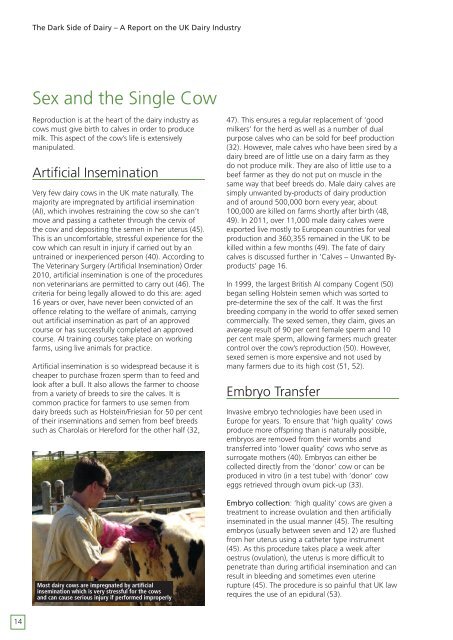Create successful ePaper yourself
Turn your PDF publications into a flip-book with our unique Google optimized e-Paper software.
The <strong>Dark</strong> <strong>Side</strong> <strong>of</strong> <strong>Dairy</strong> – A Report on the UK <strong>Dairy</strong> IndustrySex and the Single CowReproduction is at the heart <strong>of</strong> the dairy industry ascows must give birth to calves in order to producemilk. This aspect <strong>of</strong> the cow’s life is extensivelymanipulated.Artificial InseminationVery few dairy cows in the UK mate naturally. Themajority are impregnated by artificial insemination(AI), which involves restraining the cow so she can’tmove and passing a catheter through the cervix <strong>of</strong>the cow and depositing the semen in her uterus (45).This is an uncomfortable, stressful experience for thecow which can result in injury if carried out by anuntrained or inexperienced person (40). According toThe Veterinary Surgery (Artificial Insemination) Order2010, artificial insemination is one <strong>of</strong> the proceduresnon veterinarians are permitted to carry out (46). Thecriteria for being legally allowed to do this are: aged16 years or over, have never been convicted <strong>of</strong> an<strong>of</strong>fence relating to the welfare <strong>of</strong> animals, carryingout artificial insemination as part <strong>of</strong> an approvedcourse or has successfully completed an approvedcourse. AI training courses take place on workingfarms, using live animals for practice.Artificial insemination is so widespread because it ischeaper to purchase frozen sperm than to feed andlook after a bull. It also allows the farmer to choosefrom a variety <strong>of</strong> breeds to sire the calves. It iscommon practice for farmers to use semen fromdairy breeds such as Holstein/Friesian for 50 per cent<strong>of</strong> their inseminations and semen from beef breedssuch as Charolais or Hereford for the other half (32,Most dairy cows are impregnated by artificialinsemination which is very stressful for the cowsand can cause serious injury if performed improperly47). This ensures a regular replacement <strong>of</strong> ‘goodmilkers’ for the herd as well as a number <strong>of</strong> dualpurpose calves who can be sold for beef production(32). However, male calves who have been sired by adairy breed are <strong>of</strong> little use on a dairy farm as theydo not produce milk. They are also <strong>of</strong> little use to abeef farmer as they do not put on muscle in thesame way that beef breeds do. Male dairy calves aresimply unwanted by-products <strong>of</strong> dairy productionand <strong>of</strong> around 500,000 born every year, about100,000 are killed on farms shortly after birth (48,49). In 2011, over 11,000 male dairy calves wereexported live mostly to European countries for vealproduction and 360,355 remained in the UK to bekilled within a few months (49). The fate <strong>of</strong> dairycalves is discussed further in ‘Calves – Unwanted Byproducts’page 16.In 1999, the largest British AI company Cogent (50)began selling Holstein semen which was sorted topre-determine the sex <strong>of</strong> the calf. It was the firstbreeding company in the world to <strong>of</strong>fer sexed semencommercially. The sexed semen, they claim, gives anaverage result <strong>of</strong> 90 per cent female sperm and 10per cent male sperm, allowing farmers much greatercontrol over the cow’s reproduction (50). However,sexed semen is more expensive and not used bymany farmers due to its high cost (51, 52).Embryo TransferInvasive embryo technologies have been used inEurope for years. To ensure that ‘high quality’ cowsproduce more <strong>of</strong>fspring than is naturally possible,embryos are removed from their wombs andtransferred into ‘lower quality’ cows who serve assurrogate mothers (40). Embryos can either becollected directly from the ‘donor’ cow or can beproduced in vitro (in a test tube) with ‘donor’ coweggs retrieved through ovum pick-up (33).Embryo collection: ‘high quality’ cows are given atreatment to increase ovulation and then artificiallyinseminated in the usual manner (45). The resultingembryos (usually between seven and 12) are flushedfrom her uterus using a catheter type instrument(45). As this procedure takes place a week afteroestrus (ovulation), the uterus is more difficult topenetrate than during artificial insemination and canresult in bleeding and sometimes even uterinerupture (45). The procedure is so painful that UK lawrequires the use <strong>of</strong> an epidural (53).14


